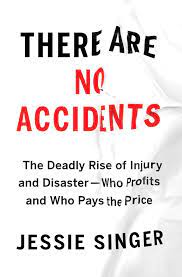You have /5 articles left.
Sign up for a free account or log in.
 There Are No Accidents: The Deadly Rise of Injury and Disaster—Who Profits and Who Pays the Price by Jessie Singer
There Are No Accidents: The Deadly Rise of Injury and Disaster—Who Profits and Who Pays the Price by Jessie Singer
Published in February 2022
In 1988, during my sophomore year of college, a student I knew was killed in a car accident. Those were pre-internet days, and I can’t find any reference on Google to his death. I think he was driving a convertible and his car flipped over near campus, but the details are hazy.
I’d not thought about this car accident and the death of a kid I went to college with for over 30 years. Reading Jessie Singer’s new book, There Are No Accidents, brought the memory back. Singer, a journalist, wrote her book in part to make sense of the death of her best friend, Eric, while cycling in Manhattan. Eric was hit by a drunk driver who drove onto a bike path.
In researching her best friend’s death, Singer discovered that other cars had routinely driven on the same bike path, as the city had failed to install barriers to protect cyclists and walkers. It was not until a man intentionally drove a pickup onto that bike path in 2017, killing eight, that the city installed solid barriers at the entrances of the bike path. In other words, if New York City had acted earlier, Singer’s friend Eric (and many others) would be alive today.
The point of There Are No Accidents is in the book’s title. The word “accidents” connotes an unavoidable outcome—the result of bad luck, chance events or malicious actions. Automobile deaths are blamed on the “nut behind the wheel.” Fatal plane crash causes are often assigned to “pilot error.” The factory worker failed to follow the safety protocols in the employee manual.
What is not typically discussed are the systemic causes of accidents. Singer points out that members of low-income and minority populations are significantly more likely to die in accidents than middle-income and nonminority individuals. Systemic racism and the outcomes of poverty are expressed as much in the mortality risk of accidents as in employment, housing and education.
Each year, over 220,000 Americans die due to an “unintentional injury.” Mostly, the social determinants of those deaths go unexplored. There is no systematic national effort to lower accidental mortality. Technologies that could reduce accidental death, such as automotive features like blind-spot warnings and lane keeping, remain expensive options as opposed to mandated safety features. Few cities or towns invest in creating protected bike lanes. Spending on safer forms of transpiration, such as trains and subways, is minuscule compared to federal and state outlays for roads and highways.
Reading There Are No Accidents got me wondering about the role of accidental death among college students. How big a deal are accidents for this population? The book points out that unintentional accidents are the leading cause of death for young adults, ahead of deaths by suicide, homicide, cancer and heart disease (in that order).
Getting data on the cause of death for college students to understand the absolute and relative risk of accidents is surprisingly difficult. From what I can tell, cause-of-death statistics across college students are not collected and published annually. (If you know how to find these data, please get in touch.)
The best I could find is a 2011 deck from research on Leading causes of mortality among American college students at four-year institutions. In that deck, the authors offer the following bullet points (slide 3):
- No published study of college student mortality rates among multiple institutions since 1939.
- No existing data regarding leading causes of mortality among 18 million college students.
- Student deaths uncommon, tragic, newsworthy.
The researchers estimate that the leading causes of death among college students are:
- Suicide
- Nonalcohol vehicular
- Alcohol-related vehicular
- Nonalcohol nontraffic injury
- Cancer
- Alcohol-related nontraffic injury
- Homicide
Search Google for “college student dies in accident,” and you will get over 56 million links. The top responses include the following:
- 21-year-old college student dies in skiing accident in New …
- Snow College student-athlete dies in car accident in Fountain …
- Wesleyan University student dies in skiing accident while …
- Florida college student nearly died in car accident—WESH
- Muleskinner UCM student dies in single-car accident
- UVA Student Dead After Car Accident—106.1 The Corner
- VCU student dies after being hit by a car while crossing the …
- Dordt Student Dies In Climbing Accident
- JMU students killed in crash identified—WTVR.com
- 2 CT University Students Killed in Mass. Crash
- Saint Mary student killed, another injured in crash returning …
- Simmons University Student Dies in Mexico …—NBC Boston
- College student dies in weekend accident on I-79 | News
- Popular Brown University student dies in bike crash in …
- Baylor student from Frisco dies after dance accident | Allen …
- Trinity College Student Killed in a Hit & Run
- LSU student from Covington dies after being struck by car
- NSU student dies in drowning accident—Spartan Echo
- Student killed in freak parking garage accident in OH
- Auburn grad student reportedly dies in electrocution accident …
- Iowa university student killed in weightlifting accident
Could it be that colleges and universities should be thinking of accidental death as a systemic problem, one that deserves institutional thinking and prevention?
Is anyone on our campuses thinking about the social determinants of accidental death within our higher education communities?
What are you reading?








